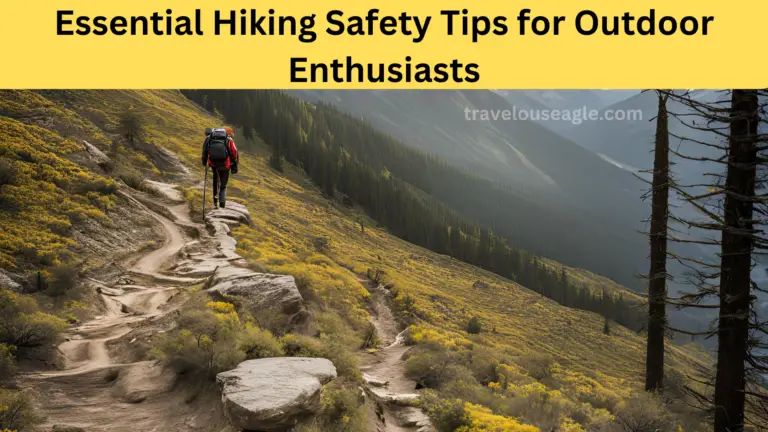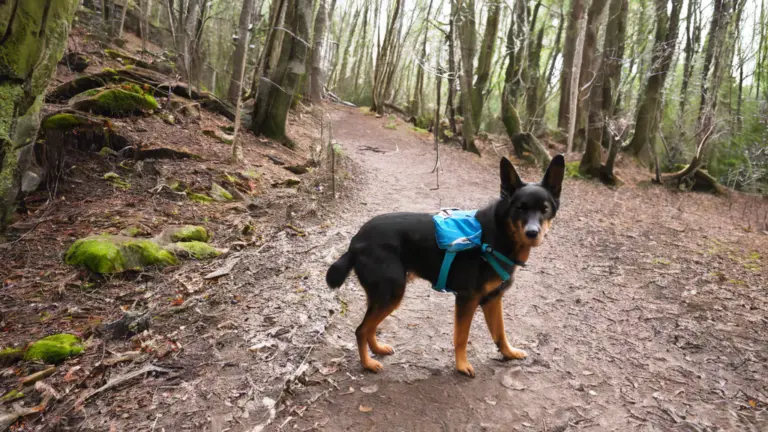How Should Hiking Boots Fit: Essential Tips for a Perfect Fit
Hiking is an exciting activity, but it requires proper preparation, especially when it comes to footwear. How should hiking boots fit, then? The key to a pleasurable hiking experience is a pair of shoes that fits perfectly.
In this article, we’ll show you how to get the best fit possible out of your hiking boots. We will discuss how to measure the length, evaluate the toe room, evaluate the heel fit, and think about the overall comfort. We’ll also talk about what to look for in a good pair of hiking shoes, as well as the role that terrain and exercise play.
Following these tips and ensuring your hiking boots are properly fitted can help you have a more comfortable and successful hike. Now is the time to dive in and learn the ins and outs of finding the perfect fit for your hiking boots.
How Should Hiking Boots Fit [Tips]

Finding the right fit for hiking boots is critical to a comfortable and enjoyable hiking experience. Here are some fitting suggestions for hiking boots.
01. Measurement of Length
Wear your preferred socks and measure the length of the hiking boots using the longer foot to guarantee a perfect fit. Before securely putting the longer foot into the boot, take out the insole and untie the laces.
Check to see whether you can slide a finger down beneath the heel by moving your foot toward the front. If you can, the boots’ length is suitable for your feet. Otherwise, they can be too big or too little.
Photo by Stephan Seeber
Finding the right fit for hiking boots is critical to a comfortable and enjoyable hiking experience. Here are some fitting suggestions for hiking boots.
01. Measurement of Length
Wear your preferred socks and measure the length of the hiking boots using the longer foot to guarantee a perfect fit. Before securely putting the longer foot into the boot, take out the insole and untie the laces.
Check to see whether you can slide a finger down beneath the heel by moving your foot toward the front. If you can, the boots’ length is suitable for your feet. Otherwise, they can be too big or too little.
02. Evaluating Toe Room
Stand straight and place both of your feet firmly within the hiking boots to measure the width of the boots. You have the perfect fit if they are snug and at ease. The boots are too narrow if you feel constricted or squashed around the sides of your foot and toes. The boots are excessively wide if, on the other hand, your feet slip side to side.
03. Assessing Heel Fit
The heel should be easily and firmly secured while walking to avoid blisters. The boots can be too tight if you experience any heel lift or movement while walking. On the other hand, if there is a gap of a quarter inch, the fit should be fine.
04. Overall Fitting Issues
It’s critical to gauge overall comfort while engaging in actual hiking activities in addition to length, width, and heel fit. Put the shoes through their paces by donning them both inside and outside during a real hike.
You can practice the terrain you anticipate encountering by leaping off a chair to represent a drop on the path or walking on sloped surfaces in your area. In these situations, pay close attention to the level of comfort and stability that the boots offer.
05. Terrain and Activity to Consider
When choosing hiking boots, consider the particular terrain and activity you will partake in. Several hiking shoes are created for diverse terrains, such as day hikes, backpacking expeditions, or mountaineering. Depending on the needs of the hikes you have planned, pick boots with the right qualities, such as ankle support, traction, and waterproofing.
ou can choose the ideal hiking footwear for your needs by being aware of your planned use.
Factors To Consider When Buying Hiking Shoes
When selecting hiking footwear, keep the following in mind:
01. Time Of Day Using
The time of day should be considered when trying on and purchasing hiking footwear. Our feet have a tendency to swell throughout the day, particularly while we’re hiking. It’s ideal to purchase hiking boots later in the day when your feet will most likely be at their largest size to ensure a perfect fit.
02. Time You Spending
Picking the best hiking boots requires a substantial financial commitment, so taking your time is critical. When looking for hiking boots, take your time and give yourself many opportunities to try on various pairs, evaluate features, and gauge comfort. Finding the ideal shoes for your needs will be easier if you give yourself the time and consideration you require.
03. Wearing Orthotics And Stockings
When evaluating hiking footwear, dress in your regular socks and orthotics. This will give you a better idea of how the shoes will feel when you go on a hiking expedition. During the testing process, be aware of any existing pressure or discomfort sites because they could result in blisters or discomfort.

04. Breaking Them Down
Before a lengthy trek, breaking into your hiking boots is crucial. Wearing your new shoes around the house or on small local hikes will help you gradually integrate them into your everyday routine. Your feet can get used to the shoes during this process, which also aids in spotting any potential issues or pain. Your hiking boots’ overall performance, comfort, and durability on the trail can be improved by breaking them in early.
05. Specialized Stores And Professional Support
For more information on professional support and specialized stores, visit specialized outdoor stores that provide a wide assortment of hiking boots. These shops frequently feature skilled employees who may offer professional advice and direction. Consult with experts who can evaluate your foot type, gait, and unique hiking demands and recommend the best shoes. Their knowledge will substantially aid your search for the ideal pair of hiking shoes.
You may ensure a more pleasant hiking experience by considering these variables, taking time throughout the choosing process, and adequately fitting your shoes before hitting the trail.
Conclusion
In conclusion, how should hiking boots fit? A comfortable and enjoyable hiking experience requires finding the correct fit for your hiking boots. You can make sure that your hiking boots fit precisely by using the aforementioned advice, which includes measuring the length, examining toe room, evaluating heel fit, taking into account overall comfort, and considering the terrain and activity.
Don’t forget to take into account additional elements such as the time of day, the amount of time spent selecting, wearing socks and orthotics when testing, breaking in the boots, and getting professional assistance. You can choose the perfect pair of hiking boots that offer the comfort, stability, and durability you require on the trails by taking these things into account.
You can set out on your trekking activities with confidence if you have well-fitted hiking boots since you will know that your feet are well-supported and safeguarded.
FAQ
How do you know if your hiking boots fit?
The boots are overly broad and could cause blisters if your foot can easily slide from side to side inside of them. The optimal fit is snug but not painful because most boots will stretch to make them more comfortable.
How much room should I have in my hiking boots?
It’s important to leave at least an inch of space between your big toe and the tip of your boots to prevent blisters. Allowing more room for your toes will provide added comfort during longer hikes when your feet tend to swell.
Do hiking boots need to be a size bigger?
Considering that feet can swell during hiking, it’s recommended to opt for hiking shoes or slightly larger boots. Generally, aim to purchase hiking boots half a size larger than what you usually wear.
Is it better to have tighter or looser hiking boots?
Hiking boots should fit snugly throughout, with no tight spots, while still offering room for toe movement. Try them on at the end of the day when your feet are more likely to be swollen and wear the socks you plan to use during hiking. Familiarize yourself with your size.
Do hiking boots loosen up?
Yes! Hiking boots are designed to stretch and mold to your feet over time, providing an increasingly comfortable fit. Similar to regular shoes, after wearing them for a while, they will gradually stretch and become more comfortable.
Post Options
Toggle panel: Post Options
Layout StyleDefaultRight SidebarFull Width
Default uses the site-wide general layout setting set in Appearance > Customize.
Post StyleDefaultCreative – Large StyleCover – Overlay StyleDynamic (Affects Full Width Layout Only)ClassicMagazine/News Style
Default uses the global settings set in Appearance > Customize
Spacious Style?DefaultYesNo
Enable to add extra left/right spacing to text to create a dynamic spacious feel. Especially great when used with Full Width.
Primary Category — Auto Detect– Hiking Destination Guides Reviews Tips
When you have multiple categories for a post, auto detection chooses one in alphabetical order. This setting is used for selecting the correct category in post meta.
Disable Featured? Do not show featured Image, Video, or Gallery at the top for this post, on post page.
Featured Video/Audio Link
When using Video or Audio post format, enter a link of the video or audio from a service like YouTube, Vimeo, SoundCloud.
- Post
- Block
Summary
VisibilityPublic
02. Evaluating Toe Room
Stand straight and place both of your feet firmly within the hiking boots to measure the width of the boots. You have the perfect fit if they are snug and at ease. The boots are too narrow if you feel constricted or squashed around the sides of your foot and toes. The boots are excessively wide if, on the other hand, your feet slip side to side.
03. Assessing Heel Fit
The heel should be easily and firmly secured while walking to avoid blisters. The boots can be too tight if you experience any heel lift or movement while walking. On the other hand, if there is a gap of a quarter inch, the fit should be fine.
04. Overall Fitting Issues
It’s critical to gauge overall comfort while engaging in actual hiking activities in addition to length, width, and heel fit. Put the shoes through their paces by donning them both inside and outside during a real hike.
You can practice the terrain you anticipate encountering by leaping off a chair to represent a drop on the path or walking on sloped surfaces in your area. In these situations, pay close attention to the level of comfort and stability that the boots offer.
05. Terrain and Activity to Consider
When choosing hiking boots, consider the particular terrain and activity you will partake in. Several hiking shoes are created for diverse terrains, such as day hikes, backpacking expeditions, or mountaineering. Depending on the needs of the hikes you have planned, pick boots with the right qualities, such as ankle support, traction, and waterproofing.
ou can choose the ideal hiking footwear for your needs by being aware of your planned use.
Factors To Consider When Buying Hiking Shoes
When selecting hiking footwear, keep the following in mind:
01. Time Of Day Using
The time of day should be considered when trying on and purchasing hiking footwear. Our feet have a tendency to swell throughout the day, particularly while we’re hiking. It’s ideal to purchase hiking boots later in the day when your feet will most likely be at their largest size to ensure a perfect fit.
02. Time You Spending
Picking the best hiking boots requires a substantial financial commitment, so taking your time is critical. When looking for hiking boots, take your time and give yourself many opportunities to try on various pairs, evaluate features, and gauge comfort. Finding the ideal shoes for your needs will be easier if you give yourself the time and consideration you require.
03. Wearing Orthotics And Stockings
When evaluating hiking footwear, dress in your regular socks and orthotics. This will give you a better idea of how the shoes will feel when you go on a hiking expedition. During the testing process, be aware of any existing pressure or discomfort sites because they could result in blisters or discomfort.
04. Breaking Them Down
Before a lengthy trek, breaking into your hiking boots is crucial. Wearing your new shoes around the house or on small local hikes will help you gradually integrate them into your everyday routine. Your feet can get used to the shoes during this process, which also aids in spotting any potential issues or pain. Your hiking boots’ overall performance, comfort, and durability on the trail can be improved by breaking them in early.
05. Specialized Stores And Professional Support
For more information on professional support and specialized stores, visit specialized outdoor stores that provide a wide assortment of hiking boots. These shops frequently feature skilled employees who may offer professional advice and direction. Consult with experts who can evaluate your foot type, gait, and unique hiking demands and recommend the best shoes. Their knowledge will substantially aid your search for the ideal pair of hiking shoes.
You may ensure a more pleasant hiking experience by considering these variables, taking time throughout the choosing process, and adequately fitting your shoes before hitting the trail.
Conclusion
In conclusion, how should hiking boots fit? A comfortable and enjoyable hiking experience requires finding the correct fit for your hiking boots. You can make sure that your hiking boots fit precisely by using the aforementioned advice, which includes measuring the length, examining toe room, evaluating heel fit, taking into account overall comfort, and considering the terrain and activity.
Don’t forget to take into account additional elements such as the time of day, the amount of time spent selecting, wearing socks and orthotics when testing, breaking in the boots, and getting professional assistance. You can choose the perfect pair of hiking boots that offer the comfort, stability, and durability you require on the trails by taking these things into account.
You can set out on your trekking activities with confidence if you have well-fitted hiking boots since you will know that your feet are well-supported and safeguarded.
FAQ
How do you know if your hiking boots fit?
The boots are overly broad and could cause blisters if your foot can easily slide from side to side inside of them. The optimal fit is snug but not painful because most boots will stretch to make them more comfortable.
How much room should I have in my hiking boots?
It’s important to leave at least an inch of space between your big toe and the tip of your boots to prevent blisters. Allowing more room for your toes will provide added comfort during longer hikes when your feet tend to swell.
Do hiking boots need to be a size bigger?
Considering that feet can swell during hiking, it’s recommended to opt for hiking shoes or slightly larger boots. Generally, aim to purchase hiking boots half a size larger than what you usually wear.
Is it better to have tighter or looser hiking boots?
Hiking boots should fit snugly throughout, with no tight spots, while still offering room for toe movement. Try them on at the end of the day when your feet are more likely to be swollen and wear the socks you plan to use during hiking. Familiarize yourself with your size.
Do hiking boots loosen up?
Yes! Hiking boots are designed to stretch and mold to your feet over time, providing an increasingly comfortable fit. Similar to regular shoes, after wearing them for a while, they will gradually stretch and become more comfortable.





